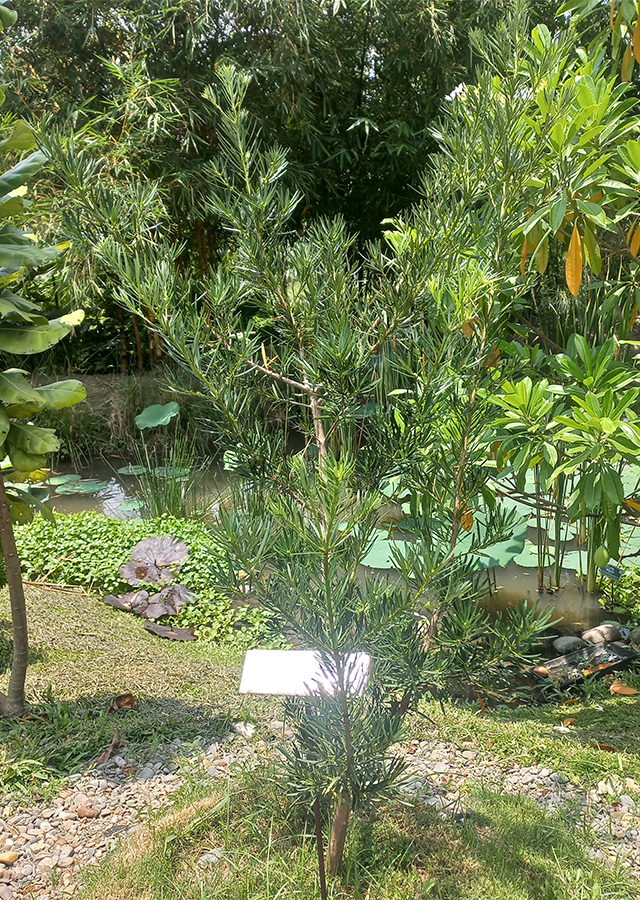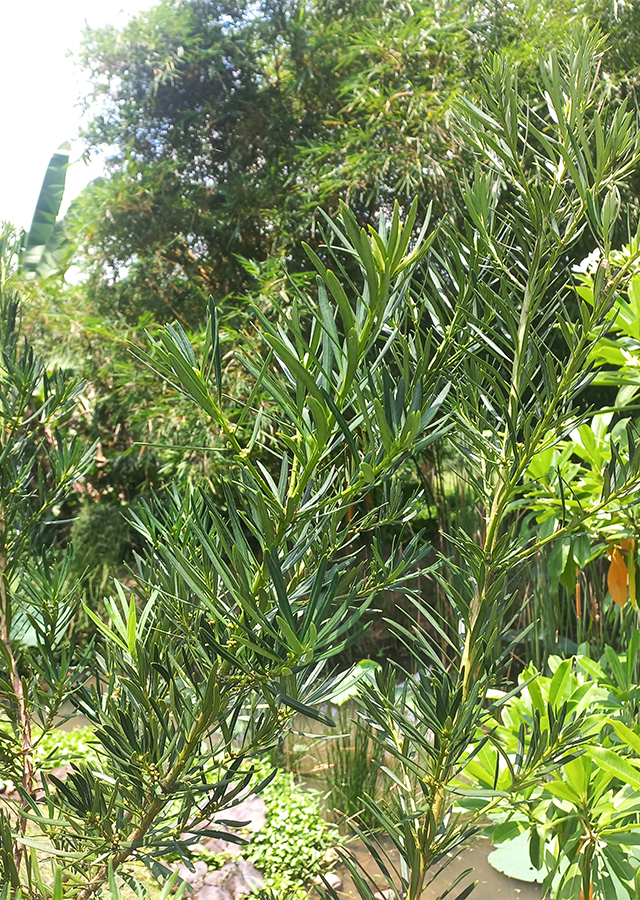Traditional Herbs from Podocarpus macrophyllus
wound
- Prepare enough fresh lohansung leaves, wash them thoroughly with running water.
- Crush them until they become a paste.
- Apply the leaf paste on the wound.
What is Podocarpus macrophyllus Looks like??



Parts of Podocarpus macrophyllus that could be used
- Leaves
- Bark
Podocarpus macrophyllus Distribution
Lohansung is a plant from the Podocarpaceae family originating from China (Anhui, Chongqing, Fujian, Guangxi, Guizhou, Hong Kong, Hubei, Hunan, Jiangsu, Jiangxi, Sichuan, Yunnan, Zhejiang), Japan, Myanmar and Taiwan. Lohansung is very popular and is often grown as an ornamental plant (especially in Japan and the southeastern United States) and a hedge plant. This species has a very unique and antique tree shape and its ability to survive in all climates, which makes this plant much sought after by ornamental plant lovers from various countries, and is also widely cultivated as a bonsai plant. Apart from being an ornamental plant and hedge plant, lohansung can also be used as a food ingredient, source of ingredients and medicine. Where, lohansung produces fruit that can be consumed fresh or used in pies and cakes. Lohansung wood is also widely used in making furniture, tools, paper, and agricultural equipment. Based on its function as a medicinal plant, lohansung also has many health benefits, and has traditionally been used in Ayurvedic medicine. Where in Ayurvedic medicine, the bark is known to function as an antiseptic, astringent and carminative and has been proven useful in the treatment of fever, asthma and coughs. Apart from that, lohansung is also considered a feng shui tree in Japan.Agroecology of Podocarpus macrophyllus
Lohansung can usually be found growing in forests, open bushes and roadsides, at altitudes ranging from near sea level to 1,000 m above sea level. This species generally grows in areas with an average annual temperature of 18.4 °C, with an average minimum temperature in the coldest month of 7.1 °C, and an average annual rainfall of 2,180 mm. Lohansung is able to tolerate winter temperatures of between -17.7 °C and -12.2 °C for a short time. This species grows best in full sun in slightly acidic, nutrient-rich, moist, well-drained soil and prefers areas where summers are hot and humid. Lohansung is tolerant of drought and shade, but not tolerant of wet soil conditions. This species can develop chlorosis (yellowing of the leaves) in alkaline soil conditions.
Morphology of Podocarpus macrophyllus
- The roots are very strong with the ability to spread throughout the surrounding soil.
- Stems are straight and cylindrical, widely branched, dense and upright. The bark is gray or greyish brown, with a rough and raised texture.", "Simple or unifoliate leaves, arranged spirally around the shoot, close together, erect to spreading, narrow-linear to lanceolate, stiff, thick, with a sharp base and a blunt or slightly sharp leaf tip, yellowish green when young and become dark green on the upper surface and pale green below, the edges of the primary leaves (midribs) are prominently raised on the upper surface and on the lower surface.
- Flowers are yellow, have male and female cones which are on separate plants.
- The fruit is a fleshy, cone-shaped berry borne on a short stem, with 2-4 scales,\u00a0usually only one (sometimes two) is fertile, has 1 or 2 holes, each hole in the fruit carries an apical seed single sized 10 - 15 mm. The fruit scales will expand and change color when ripe to reddish purple.
Cultivation of Podocarpus macrophyllus
Plant propagation uses seeds and stem cuttings (by cutting terminal shoots 5 - 10 cm long).
Podocarpus macrophyllus, more details :
Chemical Content of Podocarpus macrophyllusNew biflavonoids, 2,3-dihydro-4',4'''-di-O-methylamentoflavone, catechin, quercetin, 2,3-dihydrosciadopitysin, sciadopitysin, isoginkgetin, hinokiflavone, neocryptomerin, podocarpusflavone A, podocarpusflavone B, flavonoids, norditerpenes new (2ß-hydroxymakilatone A and 3ß-hydroxymakilatone A).
Benefits of Podocarpus macrophyllus
Treats worms, blood disorders, lungs, asthma, coughs, stomach ache, sweaty feet, gonorrhea and syphilis, cholera, rheumatism and joint pain, wounds, reduces fever, as a tonic (for the heart, kidneys and stomach), laxative. Washing in the treatment of arsenic poisoning, skin diseases and ulcers.
Simplisia of Podocarpus macrophyllus
Another Facts for Podocarpus macrophyllus :
Synonym of Podocarpus macrophyllusMargbensonia macrophylla (Thunb.) A.V.Bobrov & Melikyan, Nageia macrophylla (Thunb.) F.Muell., Podocarpus sweetii C.Presl
Habitus of Podocarpus macrophyllus
Tree. Annual tree, can grow up to 20 m high, with a trunk diameter of 60 cm
Habitat of Podocarpus macrophyllus
- Forest
- Mountains
- Roadside
No comments:
Post a Comment